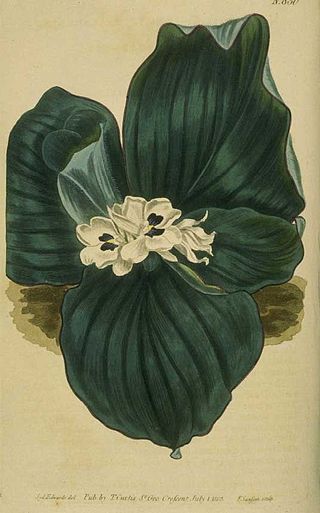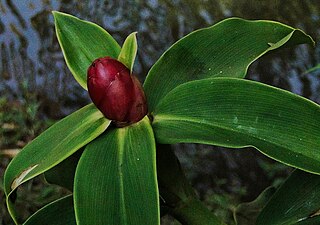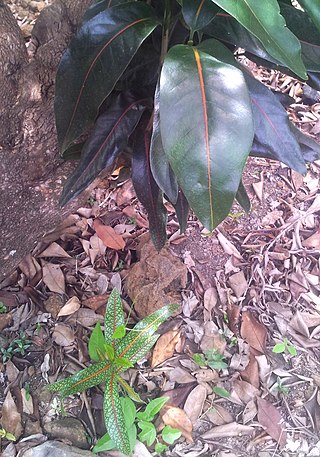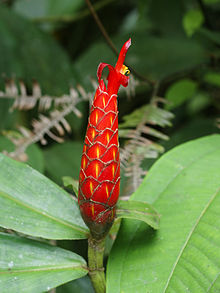
Ethnobotany is an interdisciplinary field at the interface of natural and social sciences that studies the relationships between humans and plants. It focuses on traditional knowledge of how plants are used, managed, and perceived in human societies.Ethnobotany integrates knowledge from botany, anthropology, ecology, and chemistry to study plant-related customs across cultures. Researchers in this field document and analyze how different societies use local flora for various purposes, including medicine, food, religious use, intoxicants, building materials, fuels and clothing. Richard Evans Schultes, often referred to as the "father of ethnobotany", provided an early definition of the discipline:
Ethnobotany simply means investigating plants used by primitive societies in various parts of the world.

Costus is a genus of herbaceous perennial plants in the family Costaceae, erected by Linnaeus in 1753. It is widespread through tropical and subtropical regions of Asia, Africa, and the Americas.

Kaempferia galanga, commonly known as kencur, aromatic ginger, sand ginger, cutcherry, is a monocotyledonous plant in the ginger family, and one of four plants called galangal. It is found primarily in open areas in Indonesia, southern China, Taiwan, Cambodia, and India, but is also widely cultivated throughout Southeast Asia.

Costus chartaceus, commonly known as the Christmas costus, is a perennial plant with a red inflorescence first described by Paul Maas in 1972. It is native to Colombia and Ecuador but cultivated as an ornamental in other regions. It is not winter hardy.
Ficus maxima is a fig tree which is native to Mexico, Central America, the Caribbean and South America south to Paraguay. Figs belong to the family Moraceae. The specific epithet maxima was coined by Scottish botanist Philip Miller in 1768; Miller's name was applied to this species in the Flora of Jamaica, but it was later determined that Miller's description was actually of the species now known as Ficus aurea. To avoid confusion, Cornelis Berg proposed that the name should be conserved for this species. Berg's proposal was accepted in 2005.

Boerhavia diffusa is a species of flowering plant in the four o'clock family which is commonly known as punarnava, red spiderling, spreading hogweed, or tarvine. It is taken in herbal medicine for pain relief and other uses. The leaves of Boerhavia diffusa are often used as a green vegetable in many parts of India.

Costus spicatus, also known as spiked spiralflag ginger or Indian head ginger, is a species of herbaceous plant in the Costaceae family.

Canarium strictum, known by common names including black dhup, Raal, Raal dhup and black dammar, is a species of tree in the family Burseraceae. It is known for the medicinal and commercial use of the resin it exudates, called black dammar.
Tabernaemontana sananho is a tropical tree species in the family Apocynaceae known as lobo sanango. Lobo sanango grows in the Amazon Basin of northern South America.

Heteroblasty is the significant and abrupt change in form and function, that occurs over the lifespan of certain plants. Characteristics affected include internode length and stem structure as well as leaf form, size and arrangement. It should not be confused with seasonal heterophylly, where early and late growth in a season are visibly different. This change is different from a homoblastic change which is a gradual change or little change at all, so that there is little difference between the juvenile and adult stages. Some characteristics affected by heteroblastic change include the distance between successive leaves and stem structure as well as leaf form, size and arrangement. Heteroblasty is found in many plant families as well as only some species within a genus. This random spread of heteroblastic plants across species is believed to be caused by convergent evolution.

Ina Vandebroek is an ethnobotanist working in the areas of floristics, ethnobotany and community health. Since 2005, she has worked at the New York Botanical Garden in the Institute of Economic Botany. She has worked on ethnobotanical projects in North America, the Caribbean, and South America.

Costus malortieanus, known as Stepladder Plant, Spiral Ginger, or Spiral Flag, is a species of perennial herbaceous flowering plant in the family Costaceae. It is native to Costa Rica, Nicaragua and Honduras. Costus malortieanus is often cultivated as an ornamental plant.

Tabernaemontanine is a naturally occurring monoterpene indole alkaloid found in several species in the genus Tabernaemontana including Tabernaemontana divaricata.

Ben-Erik van Wyk FAAS is a South African professor of indigenous botany and traditional African medicine at the University of Johannesburg.

Costus woodsonii, the red button ginger or scarlet spiral flag, is a species of flowering plant in the family Costaceae, native to Nicaragua, Costa Rica, Panama, and Colombia. A rhizomatous geophytic perennial, it is recommended for coastal gardens, borders, containers, and general wet, tropical garden applications. It is more widely cultivated than other species of Costus. Costus woodsonii was first described by Paul Maas in 1972 and is named for Robert Woodson of the Missouri Botanical Garden.

Costus comosus, known as red tower ginger, is a species of plant native to South Mexico to Ecuador.
Costus scaber is a species of plant in the Costaceae family. Its native range is Mexico to Tropical America.

Costus productus, known as orange tulip ginger, dwarf orange ginger, or green mountain spiral flag, is a species of plant in the Costaceae family. Costus productus is native to South Colombia and Peru.

Costus pictus, known as painted spiral ginger or spotted spiral ginger, is a species of plant in the Costaceae family. Its native range is Mexico to Central America.

















